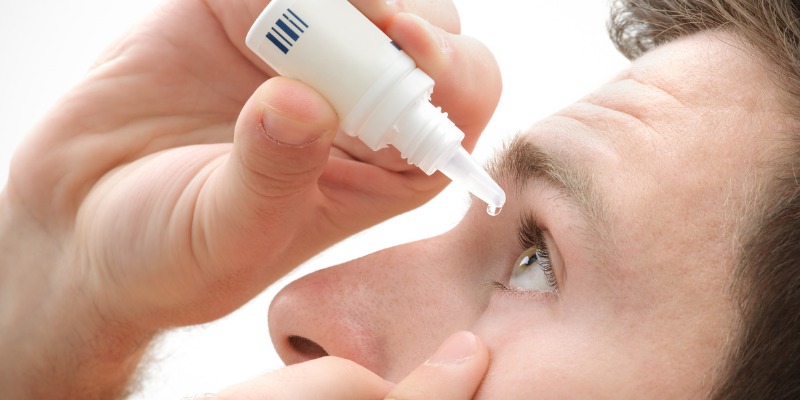The good news about dry eye syndrome (or dry eye disease) is that in most cases it can be easily treated without the opportunity for severe complications to emerge. The bad news is that even if you have a case that does not cause serious complications, there is nothing fun about having this ocular disorder. The symptoms range from annoying to downright uncomfortable and having irritated eyes can prevent you from being able to focus effectively at work. If you suspect you have a case of dry eye you should see your eye doctor as soon as possible, follow their instructions for treatment and maintain good eye hygiene in order to prevent recurrences.
What Is Dry Eye Syndrome?

According to the National Institutes of Health:
Dry eye disease is defined as a “multifactorial disease of the tears and ocular surface that results in symptoms of discomfort, visual disturbance, and tear film instability with potential damage to the ocular surface. It is accompanied by increased osmolarity of the tear film and subacute inflammation of the ocular surface.”
The ocular surface (cornea, conjunctiva, accessory lacrimal glands), meibomian glands (specific sebaceous glands of the eyelid margin, which produce the outer lipid film of the tear film), the main lacrimal gland, and the innervation between them form a functional unit. Any or all of these structures may be affected in dry eye disease. Recent studies have shown that dry eye is an inflammatory disease that has many features in common with autoimmune disease. Stress to the ocular surface (environmental factors, infection, endogenous stress, antigens, genetic factors) is postulated as the pathogenetic triggering mechanism. Proinflammatory cytokines, chemokines, and matrix metalloproteinases lead to the expansion of autoreactive T helper cells which infiltrate the ocular surface and lacrimal gland. The result is a vicious circle of damage to the ocular surface and inflammation.
Classification into “dry eye with reduced tear production (aqueous-deficient)” and “dry eye with increased evaporation of the tear film (hyper evaporative)” has proved useful on practical grounds.
Around 10% of patients with dry eye have a solely aqueous-deficient disorder. Hyper Evaporative disorders, mostly caused by dysfunction of the meibomian glands, and mixed hyper evaporative/aqueous-deficient forms account for more than 80% of cases. Based on this new insight, novel diagnostic procedures and therapeutic approaches have evolved… Dry eye disease is an inflammatory disease that has many features in common with autoimmune disease… between 5% and 34% of people suffer from dry eye; prevalence increases significantly with age.
Dry eye is also known as keratoconjunctivitis sicca (KCS) which is used to describe the condition when it affects the cornea and the conjunctiva; keratitis sicca when dryness and inflammation affect just the cornea; and dysfunctional tear syndrome. In this last case, the basal tears that the body produces to keep the eyes moist and lubricated are insufficient in quantity and quality. (Source).
Basal Tears and Your Eyes

Basal tears keep your eyes comfortable, healthy, free of foreign particles, and able to see. These tears also help to keep your eyes free of infection. The tears create a film that is spread across the eye every time you blink. There are several components to them:
- Lipid (an oil). This is produced by the meibomian glands that are found in the eyelid and helps to prevent evaporation of the tear, as well as to increase lubrication.
- Aqueous (water). This is produced by the lacrimal glands that are found behind the outer parts of the upper eyelids.
- Mucin (a mucus), which helps to keep the tears on the surface of the eyes and spread them across those surfaces. It is made by the goblet cells in the conjunctiva, which is the clear film that covers the eye’s white parts (sclera).
Any issue with any of these can cause instability of the tears and dry eye, the exact symptoms and cause will depend on what is happening with those components. This will also determine the course of action your eye doctor will recommend. (Source).
Generally, people who suffer from dry eye have some combination of the following symptoms:
- Feeling like there is a foreign body in the eye
- A gritty feeling on the eyeball
- Discharge from the eye or eyes
- Irritation
- Dryness
- Tearing that is excessive
- Itchiness
- Blurry or inconsistent vision
- Redness
- Light sensitivity
Causes of Dry Eye Disease
Certain environments seem to exacerbate dry eye symptoms. Anywhere that is smoky or dry is certainly going to increase the irritation, as is indoor forced heat or cooling, as well as the wind. Reading and computer use will also impact this. Post-traumatic stress disorder and depression have been shown to have a positive correlation to the disease in veterans. (Source). In fact, as reported in the Review of Optometry, “various intrinsic and extrinsic risk factors, to name just a few, include gender, genetics, tear quality, age, hormones, immune status, nutrition, pathogens, contact lenses/refractive surgery, and environmental stress, any of which can alter the harmonious balance within the ocular surface.” These factors mean that millions of people around the world suffer, or are at risk of suffering, from dry eye each year.
Despite the historic trend of dry eye being more prevalent in people as they age, there has been a recent significant uptick of dry eye in children that is associated with the extensive use of smartphones and other handheld devices. When people use devices they tend to not blink as much, leaving their eyes dry. Over time the effects can be cumulative and damaging. Children who are spending hours each day using devices for communication and games are prone to dry eye syndrome. A recent Korean study found:
Among the participants, 9.7 percent were diagnosed with dry eyes, and 90.3 percent comprised the control group. Smartphone use was more common in the dry eye group than the control group (71 percent vs. 50 percent), and increased daily duration of smartphone use was associated with increased risk of dry eye disease, as was the total hours per day spent using all video devices combined.
One interesting finding is that increased duration of computer use and television viewing measured separately did not increase the risk of dry eye disease.
The study authors concluded that smartphone use is an important dry eye disease risk factor in children and that parents should monitor the amount of time their children spend using video displays, especially smartphones, on a daily basis. The study report appeared in the April 2014 issue of Journal of Pediatric Ophthalmology and Strabismus.
On top of that, Demodex mites can cause dry eye syndrome to occur.
Demodex Mites and Dry Eyes
Demodex mites are microscopic arachnids that spend their entire life cycle living on, and from, their host. The two types of mite that infect human populations (Demodex folliculorum and Demodex brevis) are found on people in every country in the world and have some level of population on almost every adult. People are not born with these mites, but get them from parents and then transfer them from person to person with close physical contact. The mites are nocturnal and consume skin cells and sebum, the oils that are produced by the sebaceous glands in human skin.
Of the two, Demodex folliculorum is the most common. It is slightly larger than Demodex brevis and primarily inhabits the hair follicles, or roots of your eyelashes. There, Demodex folliculorum eats cells that line the hair follicle. The problem, however, is that the mite’s waste material can become built up inside the hair follicle of your eyelashes, resulting in signs of blepharitis, such as dryness, redness, itching, sensitivity to light, loss of eyelashes, and crusty eyelashes and eyelids.
Demodex folliculorum can also carry harmful bacteria like Staphylococcus and Bacillus oleronius, which can result in serious infections.
Demodex brevis is very similar to Demodex folliculorum, with the primary differences being that Demodex brevis is smaller and it tends to inhabit the meibomian glands, rather than the hair follicles. The meibomian glands are vertical structures located in both the upper and lower eyelids and open at the base of the eyelashes. Their primary function is to secrete an oily substance called meibum, which is made up of components like fatty acids, fatty alcohols, cholesterol, phospholipids, diglycerides, triglycerides, and hydrocarbons. This substance lubricates and protects the eyes, while also preventing tears from evaporating from the surface of the eye.
When there is an infestation of Demodex brevis living within the meibomian glands, they can become clogged and therefore may result in an eye condition called meibomian gland dysfunction, or MGD. Signs of MGD can be similar to those of blepharitis and dry eye disease and usually include dryness, redness, itchiness, and light sensitivity. (Source).
The bacteria (staphylococcus) that live on the surface of the mites themselves can trigger an immune system response in people which can lead to inflammation. If this continues and becomes chronic it can also become progressive, with the inflammation spreading to the conjunctiva and the cornea. This can lead directly to dry eye and progress to other corneal issues. (Source). Demodex mites can also trigger dysfunction of the meibomian and other glands, leading to complications that trigger dry eye. Their presence is a well-established source of many cases of blepharitis, a different, but related eye disorder. (Source).
Cliradex Is the Best Relief for Dry Eye

The best way to manage your eye health and dry eye symptoms is with Cliradex, made by Bio-Tissue. Cliradex is a gentle, preservative-free, vegan eye and skin wash that is made with the active ingredient 4-terpineol which, among other positive benefits kills Demodex mites at all life cycle stages. Cliradex helps manage symptoms associated with a number of conditions including:
- Blepharitis – a swelling or inflammation of the eyelids, usually where the eyelash hair follicles are located
- Meibomian gland dysfunction (MGD) – the most common form of lid margin disease which can cause or exacerbate dry eye symptoms and eyelid inflammation
- Demodex infestation – species of human mites living on the eyelid, in or around the lash follicles. There are two types of mites: folliculorum, which are found in the hair follicle; and brevis, which live in the glands.
Dry eye – there are many factors that contribute to dry eye syndrome. Symptoms can be caused by varying conditions. Improved ocular hygiene practices are often recommended for people suffering from dry eyes. Conjunctivochalasis can be a contributing factor in dry eye.





